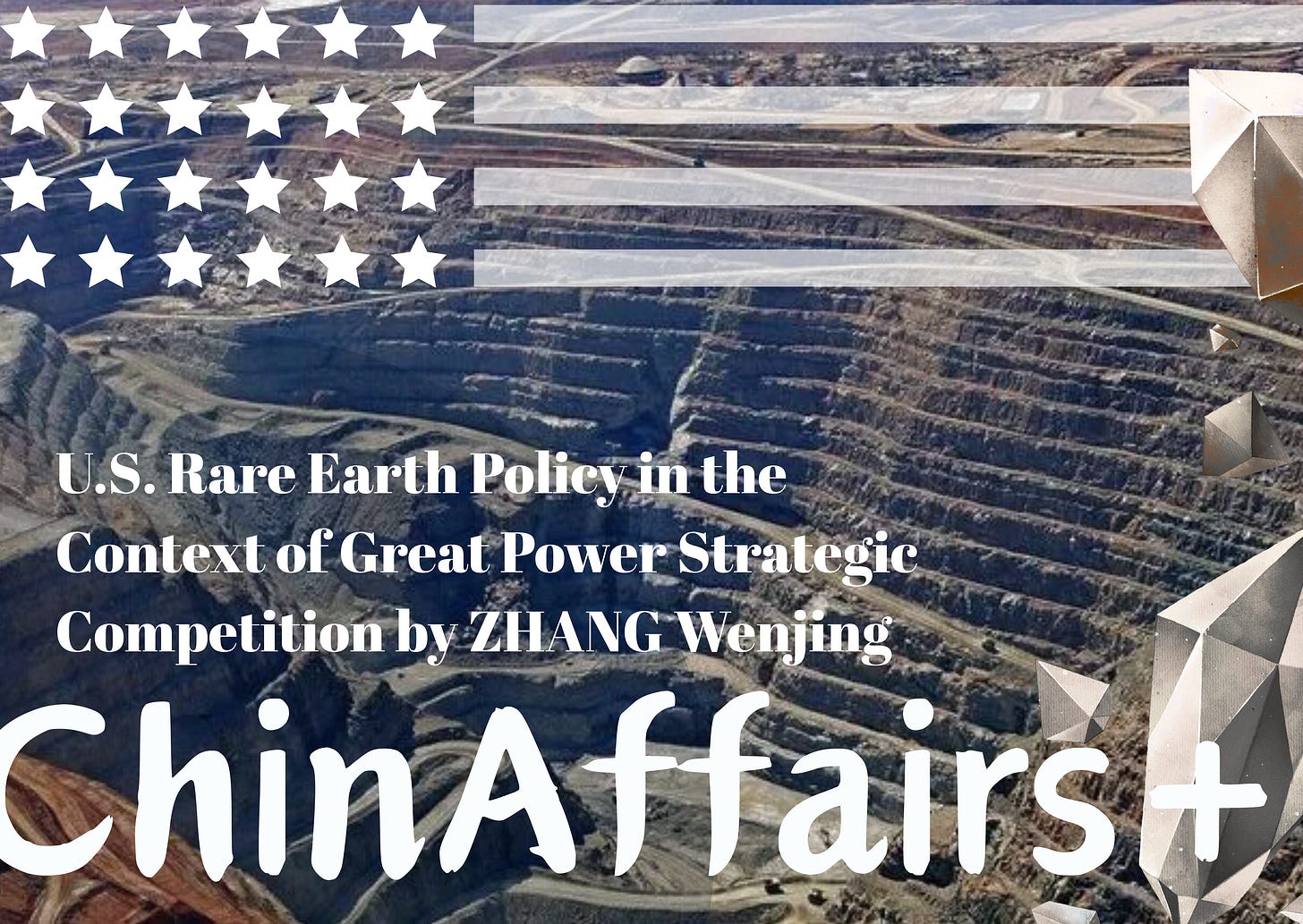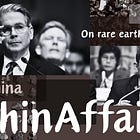U.S. Rare Earth Policy in the Context of Great Power Strategic Competition by ZHANG Wenjing
As competition intensifies, China must prepare for sustained strategic contestation, reinforcing its technological, industrial, and diplomatic advantages in current rare earth landscape.
Welcome to the 62nd edition of our weekly newsletter! I am SUN Chenghao, a fellow with Center for International Security and Security(CISS) of Tsinghua University, Council Member of The Chinese Association of American Studies, a visiting scholar at Paul Tsai China Center of Yale Law School in 2024 and Munich Young Leader 2025.
ChinAffairsplus is a newsletter that shares articles by Chinese academics on topics such as China’s foreign policy, China-U.S. relations, China-Europe relations, and more. This newsletter was co-founded by my research assistant, ZHANG Xueyu, and me.
Through carefully selected Chinese academic articles, we aim to provide you with key insights into the issues that China’s academic and strategic communities are focused on. We will highlight why each article matters and the most important takeaways. Questions and feedback can be addressed to sch0625@gmail.com
Today, we have selected an article written by Zhang Wenjing, which focuses on U.S. Rare Earth Policy and Prospects.
Summary
As a critical resource underpinning emerging technology industries and national defense, the stability of rare earth supply has become a key issue for both national and industrial security. With the escalation of China-U.S. strategic competition and increasing supply chain security risks, rare earth security has been incorporated into the U.S. national security agenda.
In recent years, in order to reduce dependence on China, the U.S. government has intensified policy interventions in the rare earth sector, seeking to rebuild a self-sufficient and controllable rare earth supply chain through measures such as restructuring the domestic industrial chain, deepening multilateral resource cooperation, and implementing import restrictions and technological blockades against China.
While these measures have shown some initial results, their overall progress remains constrained by a weak industrial base, fragmented authority between the federal and local governments, and inadequate coordination mechanisms in international cooperation. Given the strategic importance of rare earths, it can be expected that the U.S. will continue to increase investments and promote rare earth supply chain development, further intensifying U.S. China competition in this domain.
Why it Matters
Rare earth minerals, due to their unique electromagnetic, optical, and chemical properties, play an irreplaceable role in aerospace, defense, and advanced electronics, making them indispensable to the modern industrial system. As artificial intelligence and next-generation communication technologies advance, the strategic importance of rare earths and other critical minerals has further increased, with supply chain security becoming a central focus of NATO, the EU, and the United States in building defense resilience. However, the ongoing Russia–Ukraine conflict and the intensifying U.S.–China strategic rivalry have heightened geopolitical tensions, straining relations between Europe, the United States, and their traditional rare earth suppliers. In response to U.S. export controls and tariffs, China has leveraged rare earth export restrictions as an effective countermeasure, compelling Washington to reassess its supply vulnerabilities and return to the negotiation table.
Although China announced the one-year suspension of the new rare earth export control regulations introduced on October 9 following the Xi-Trump summit, reducing dependence on each other’s critical resources still remains a major “storyline” in China-U.S. relations. From October 26 to 29, Trump still signed four key mineral agreements with Thailand, Malaysia, Cambodia, and Japan. On October 31, at the G7 Energy Ministers’ Meeting held in Canada, Trump also announced that the U.S. would lead the establishment of a critical minerals production alliance aimed at reducing reliance on China in the rare earth sector.
In general, the U.S. now is pursuing a three-pronged strategy to achieve a self-sufficient rare earth supply chain: rebuilding domestic production capacity, advancing “friend-shoring” and allied cooperation, and promoting the “de-China (去中国化)” of the industry. Yet, these efforts face persistent challenges, including high production costs, limited industrial capacity, bureaucratic inefficiencies, and the slow materialization of multilateral cooperation. Nonetheless, ensuring rare earth security has become a bipartisan consensus in Washington, and the U.S. retains significant advantages in scientific innovation and alternative material research. Over the long term, these strengths could enable a partial decoupling from Chinese supply chains—reshaping the global landscape of critical mineral governance.
Key Points:
1. The Background of U.S. Efforts to Rebuild the Rare Earth Supply Chain
Rare earth elements (REEs)—comprising 17 metals including the lanthanides, scandium, and yttrium—are not geologically rare, but their complex co-occurrence, costly extraction, and environmentally damaging refining processes make them strategically scarce. Supply disruptions can severely affect multiple industries. REEs are indispensable for high-frequency communications, quantum computing, and aerospace technologies, as well as precision-guided weapons, radar systems, and clean energy applications such as wind turbines and electric vehicles.
Owing to their unique properties and limited accessibility, rare earths have become a critical resource shaping national competitiveness and security. Globally, proven reserves are concentrated in China, Brazil, India, and Australia, with China holding roughly 44 million tons—about 49% of the world total—while the U.S. accounts for only around 2%. Moreover, China possesses the world’s most integrated rare earth industrial system, spanning mining, separation, and high-end processing, whereas the U.S. and its allies suffer from fragmented supply chains, limited midstream refining capacity, and heavy reliance on imports.
As U.S.–China strategic rivalry intensifies, rare earth supply chain security has become a national priority for Washington. Despite possessing certain reserves, the U.S. struggles with low commercial viability, high extraction costs, and inadequate infrastructure. China, by contrast, controls over 90% of global separation capacity and dominates high-performance magnet manufacturing, making any Chinese export restriction a potential shock to the entire U.S. defense and technology ecosystem.
2. U.S. Policy Pathways for Supply Chain Reconstruction: Domestic Production, Allied Cooperation, and “De-Chinaization”
The Trump administration’s Executive Order 13817 (2017) and subsequent 2020 executive order marked a strategic shift from market-driven to state-led intervention in rare earth policy. The U.S. government began rebuilding its domestic industrial base, strengthening allied partnerships, and reducing dependence on China.
(1) Rebuilding the Domestic Supply Chain: Washington prioritized 17 critical rare earth elements, launched the Earth Mapping Resources Initiative to enhance geological exploration, and incorporated deep-sea minerals into its strategic reserves. The Biden administration extended this agenda by reviewing supply chains for semiconductors, batteries, pharmaceuticals, and critical minerals, while easing environmental review to accelerate extraction and processing projects. To fill midstream gaps, the U.S. increased investment in refining technologies, supporting companies such as USA Rare Earth, and promoted R&D on separation and extraction methods. At the downstream level, permanent magnet manufacturing has been elevated to a national defense priority.
(2) “Friend-shoring” and Allied Collaboration: Since 2017, the U.S. has expanded bilateral and multilateral cooperation with resource-rich allies to build a rare earth supply chain independent of China. Key bilateral efforts include the U.S.–Australia Critical Minerals Partnership and the Canada–U.S. Joint Action Plan on Critical Minerals Collaboration. The U.S. has also sought partnerships in Africa, Latin America, Southeast Asia, and the Arctic.
To broaden its reach, Washington launched the Minerals Security Partnership (MSP) in 2022, engaging G7 members, Australia, India, and Estonia to coordinate exploration, extraction, and processing globally. Rare earth issues have also been incorporated into broader trade and security frameworks, gradually forming a U.S.-centered network for global mineral cooperation.
(3) Import Controls and Technological Restrictions on China: To curb China’s dominance, Washington has imposed tariffs on Chinese rare earth magnets, restricted exports of precision refining equipment under the Commerce Control List, and used procurement incentives to redirect investment toward non-Chinese suppliers. The U.S. also aims to attract talent and secure proprietary technologies to close the gap in high-end processing and magnet manufacturing. While China remains a leader in extraction and refining, the U.S. retains advantages in advanced testing and magnet performance equipment. Export control measures are thus designed to prevent sensitive technologies from flowing back to China, reinforcing the technological front of the rare earth competition.
3. Structural Constraints in Rebuilding the U.S. Rare Earth Supply Chain
(1) Industrial Challenges: Limited Capacity and Technological Gaps
The primary difficulty in reviving the U.S. rare earth industry lies not in funding or policy incentives, but in long-term structural deficiencies caused by decades of industrial hollowing-out. The United States retains geological reserves of rare earths, yet many deposits are located in remote or environmentally sensitive regions such as Alaska and Nevada, where complex geology, weak infrastructure, and high remediation costs make extraction uneconomical. Some deposits are co-located with radioactive thorium and uranium, further increasing costs and regulatory burdens. Additionally, the U.S. currently lacks both refining and magnet-manufacturing capacity—nearly all permanent magnets are imported, while China produces over 90% of global output, dominating every stage from material synthesis to component assembly. Even if the U.S. revives upstream mining, its inability to process and fabricate downstream products will remain a key bottleneck.
A second major obstacle is the erosion of human capital. Since the 1990s, the collapse of the domestic rare earth sector has led to the loss of experienced engineers, while universities have phased out specialized programs in metallurgy and rare earth chemistry. As a result, the U.S. faces a severe shortage of skilled professionals, leaving federal initiatives with clear policy direction but inadequate technical capacity to implement them.
(2) Institutional Challenges: Fragmented Governance and Coordination Deficits
Despite elevating critical minerals to a national security priority, the U.S. rare earth governance system remains fragmented and inefficient. Responsibilities are dispersed among the Departments of Energy, Interior, Defense, Commerce, and the Environmental Protection Agency, with overlapping mandates and limited interagency coordination. Attempts to establish interdepartmental task forces have had limited success due to a lack of legal authority, budgetary control, and enforcement mechanisms. Moreover, divergences between federal and state governments, especially in environmental regulation, taxation, and land approval, further constrain implementation. Meanwhile, state-level autonomy in permitting and environmental oversight often undermines federal policy momentum.
(3) International Cooperation Challenges: Limited Institutionalization and Divergent Interests
U.S. efforts to “de-China” in rare earth supply chains through friend-shoring and resource alliances face both structural and political constraints. Partner nations such as Australia, Canada, and India possess certain resource advantages but lack comprehensive midstream refining and downstream manufacturing capabilities. Many also have limited heavy rare earth reserves, making full supply-chain substitution unrealistic.
Initiatives like the Minerals Security Partnership (MSP) and the Partnership for Global Infrastructure and Investment (PGII) remain largely declarative, without formal legal frameworks, unified funding mechanisms, or standardized decision-making processes. Consequently, project coordination is ad hoc and outcomes fall short of expectations.
Additionally, some partner countries continue to maintain or even expand cooperation with China based on their own economic interests, weakening the coherence and credibility of U.S.-led initiatives.
4. Outlook: Strategic Persistence amid Structural Constraints
(1) Bipartisan Consensus and Policy Continuity
Ensuring rare earth security has become a rare bipartisan consensus in Washington. Since Executive Order 13817 (2017), both the Trump and Biden administrations have treated rare earths as a strategic resource central to national security. The Biden administration has institutionalized long-term support mechanisms, offering continuity and predictability for industry investment and capacity recovery.
(2) Innovation and Research Advantages
The U.S. retains a world-leading foundation in basic research, supported by national laboratories, elite universities, and private-sector innovation. Advances in materials science, green metallurgy, and recycling provide long-term potential to offset industrial weaknesses. Firms such as MP Materials and USA Rare Earth have begun to commercialize extraction and processing technologies, while the U.S. continues to attract global high-end talent, partially alleviating technical skill shortages.
(3) Alliance Leverage and Multilateral Mechanisms
According to the International Energy Agency (IEA), Australia and other allies are expected to emerge as significant rare earth suppliers by 2030. Deepened cooperation with these partners, coupled with institutional mechanisms like the MSP, will gradually strengthen U.S. resilience and influence over global supply standards.
Conclusion
Although the U.S. faces formidable near-term challenges—industrial gaps, institutional fragmentation, and weak international coordination—its long-term prospects remain cautiously optimistic. If federal policy continuity, fiscal commitment, and technological innovation persist, the U.S. could establish a more secure and autonomous rare earth supply chain within the next decade. According to projections by the U.S. Department of Energy and Department of Defense, by 2032 the U.S. may achieve an annual output of 10,000 tons of rare earth oxides, covering roughly 50% of its 2015 domestic demand, and by 2027, a preliminary supply chain spanning mining, separation, and magnet production could be in place.
Nevertheless, studies such as Econofact (Tufts University) caution that building a fully integrated industry comparable to China’s may still take 15–20 years. The Associated Press similarly notes that the U.S. will require decades of accumulation to rival China’s scale and efficiency. As competition intensifies, China must prepare for sustained strategic contestation, reinforcing its technological, industrial, and diplomatic advantages in anticipation of a more diversified yet contentious global rare earth landscape.
About the Author
ZHANG Wenjing: Ph.D. Candidate at the School of Marxism Studies, University of the Chinese Academy of Social Sciences.
About the Publication
The Chinese version of this article was published in Contemporary American Review,(《当代美国评论》). It is an academic quarterly journal supervised by the Chinese Academy of Social Sciences (CASS) and jointly sponsored by the Institute of American Studies at CASS and the Social Sciences Academic Press, founded in 2017. Since its inception, the journal has been awarded the title of “Most Popular New Journal” multiple times by the National Center for Philosophy and Social Sciences Documentation. It is currently listed in AMI Comprehensive Evaluation Report of Chinese Journals of Humanities and Social Science(2022) and the China Social Science Excellence by Renmin University of China (2022)(人大复印报刊资料).









